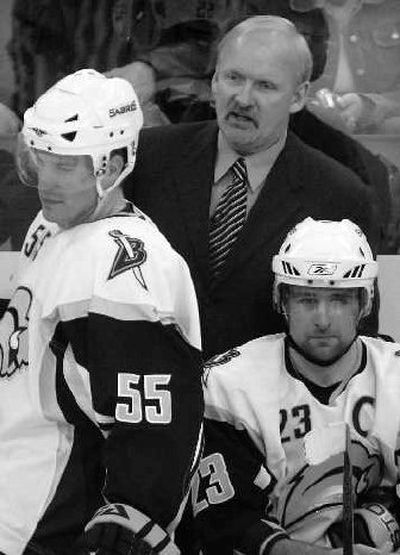Buffalo fans getting their nickel’s worth

BUFFALO, N.Y. – Of all the things Ryan Miller has seen with a Buffalo Sabres’ logo slapped on it – from cookies to cakes, bumper stickers to beer labels – this one stood out.
The Sabres goaltender recently met a young woman with his face tattooed on her calf.
“I was kind of blown away,” Miller said, shaking his head but remaining impressed by the likeness. “It’s pretty humbling but a little surreal, too. It seems like we’re being treated like rock stars.”
Sabres mania has hit town, and has started to bubble over as the team prepares to enter the playoffs next week as the Eastern Conference’s top seed with one objective – winning the Stanley Cup.
Everyone – and that includes Bishop Edward Kmiec – is on board with the blue and gold.
When The Buffalo News unveiled a series of Sabres collectible medallions last month, fans began lining up at stores at 6 a.m. each day for the $2.99 trinket. When coach Lindy Ruff was fined $10,000 by the NHL in February, it took one local pizza parlor a month to raise the money, which will be donated to charity.
There are grocery stores where employees wear Sabres outfits as uniforms. The team’s games have been sold out since December, with a 6,000-person waiting list for season tickets. And good luck getting a personalized jersey – the wait at the team store is two months; while six of the NHL’s top 10-selling sweaters belong to Sabres players.
Which leads to Kmiec, who was recently presented his own jersey after the team learned he was wearing one of the Sabres’ older-style red-and-black tops.
“I do have an inside track,” Sabres owner Tom Golisano said with a wink, when asked where he managed to find a jersey.
“I wear it at our confirmations,” Kmiec said. “I say the word, ‘Sabres,’ and I have everybody’s attention completely.”
“Divine intervention?” Golisano said. “Not quite, but it’s close.”
The Sabres will take whatever help they can get because they’re regarded as having the best chance to raise the spirits of an economically troubled region. Besides, they play in a city whose two professional sports franchises have known only playoff despair.
The Sabres have lost both times they’ve reached the Stanley Cup finals, including 1999 when the series was decided by what is still known as “No Goal.” That’s when Dallas’ Brett Hull scored the Cup-clinching goal in triple-overtime of Game 6, even though he had his foot in the crease.
Then there’s the Bills, whose Jim Kelly-led teams came away with nothing despite reaching four Super Bowls in the early 1990s.
Enter the Sabres, who have become the league’s model of success since the NHL lockout ended in the summer of 2005.
In two years, Buffalo has had consecutive 50-win seasons. And if not for losing six regulars to injuries last spring, the Sabres had a shot at competing for the Cup before their playoff run ended with a Game 7 loss in the East finals to eventual champion Carolina.
Returning with their core intact this season, the Sabres picked up where they left off by winning their first 10 games to match an NHL record, and became only the fourth team in league history to win 20 of its first 25.
What’s remarkable is how the Sabres have bounced back after enduring their low point in January 2003. That’s when the then-ownerless team declared bankruptcy before Golisano stepped in and rescued the franchise.
The Sabres are projected to enjoy a second straight profitable year, even though the team’s payroll ballooned to $44 million, about $14 million over last year.
“I wouldn’t use the word shocked,” said Daniel DiPofi, the Sabres chief operating officer. “I would say that it’s really exceeded what our expectations of growth were.”
Profits aside, Golisano senses the deep impact the Sabres have made on the community.
“There’s no question that some parts of upstate New York, and Buffalo is included in that, has had an inferiority complex for a while,” Golisano said. “And to have this team emerge like it has, has been very, very good for the psyche of the area.”